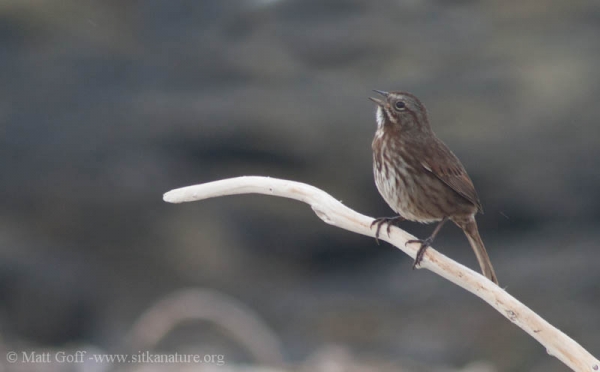My second post in the series about singing birds around Sitka is on the sparrows. (previously I wrote about Thrushes). There are only four commonly breeding sparrows known from the Sitka area. There are some additional species that migrate through and may be heard singing during a brief window of time in spring, but I’ll save those for another time.
As a whole, the sparrow songs present a bit more of a challenge than the thrushes. Dark-eyed Junco wouldn’t be mistaken for any other sparrow around Sitka, but it can be a challenge to learn to distinguish from Orange-crowned Warbler. Although their songs are fairly distinct, they are not necessarily so easy to describe and/or imitate, which contributes to the challenge of getting a feel for the differences between Song Sparrows, Fox Sparrows, Lincoln’s Sparrows and some of the warblers.
- Dark-eyed Junco
- Song consists of a simple trill that generally stays at the same pitch
- Speed of trill is generally consistent, but occasionally they will mix in a much faster trill
- Most likely to be confused with Orange-crowned Warbler whose song usually changes pitch
- Juncos are found from sea level to tree line. They seem fond of forest edges, and utilize residential areas with mixed treed and open habitats
- Juncos are present year round and often start singing while still in their large winter flocks.
- All about birds page for Dark-eyed Junco
- Song Sparrow
- Song often starts with a pitched repeated two or three times before going into the rest of the song
- In studies done elsewhere, individual males typically have 5-8 songs they will sing (with all the residential singers in Sitka it would be interesting to see if that’s true here as well)
- Listen for buzzy trills in songs to help distinguish it from the somewhat similar (looking and sounding) Fox Sparrow
- Common in residential areas where there is sufficient brushy habitat . Also found along beach margins (as well as harbors, both the floats and the breakwaters); they do not seem to occur elsewhere
- Present year round (though wintering birds are not necessarily same as breeding birds). They start singing by March.
- All about birds page for Song Sparrow
- Fox Sparrow
- Song has beeps and whistles reminiscent of R2-D2 (from Star Wars), which may be the easiest way to tell it apart from the Song Sparrow
- Utilizes brush areas from sea level to tree line. Seem to be less common than Song Sparrows in most residential neighborhoods around Sitka.
- Winter in small numbers, can be abundant during migration – singing probably starts in April (I should check my records).
- All about birds page for Fox Sparrow
- Lincoln’s Sparrow
- Song is something like a bubbling trills
- Found at the edge of wet areas including Swan Lake, Starrigavan Estuary, and muskegs.
- Once recognized, song probably not easily mistaken for anything else that occurs in Sitka, though it might give the impression of something warbler-like.
- Does not typically winter in Sitka, our latest arriving sparrow. I should check records, but it seems like late April is when they might start singing.
- All about birds page for Lincoln’s Sparrow

Thanks for your great web log on the birds of Sitka. We live on Haida Gwaii and keep an eye out for birds here as well, and we loved your cuckoo story, it might actually show up here. We have an occasional log as well, at haidagwaiibirds.com although I’m not always up to date. We will bookmark your page and thanks again.